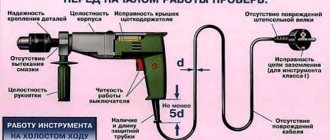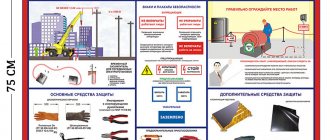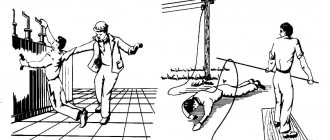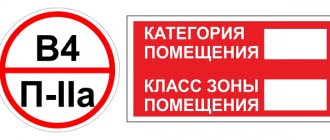The main point to pay attention to when working with any electrically powered equipment is safety. It is on this basis that a special classification of premises for electrical safety has been created. The quality of work performed by a person is influenced not only by skills, but also by the atmosphere in which the activity is carried out. If there are unpleasant gases or other impurities in the air, this will negatively affect performance. Additionally, the presence of vapors and high humidity in the air can dramatically increase the likelihood of electric shock from electrical equipment. Temperature indicators are also important.
Electrical Warning
Difference in working areas
In order to understand in more detail the degree of danger of electric shock, it is necessary to understand what kind of premises exist. There are three main categories of premises:
- Non-high hazard – these are work areas where there is no need to wear protective equipment, and there is no risk of electrical injury;
- High-risk areas are places where you need to wear special equipment for protection. There is a risk of receiving an electric shock from a certain device;
- Particularly dangerous areas are areas where only specialists wearing special protective equipment work. There is a high risk of getting an electric shock if safety rules are not followed.
Absolutely all premises used by a person in everyday life and work where electrical installations or any other electrical equipment are present are divided into such classes. The classification was created in order to minimize the risk of electric shock, since the likelihood of death if affected is quite high.
Important! Human life depends on compliance with safety precautions when staying in rooms with electrical equipment, therefore, when working with electrical installations, the established rules should not be neglected.
To study in more detail the level of danger of work in each individual work area, you should consider in more detail the classification of each room according to the danger of electric shock.
Classification of premises according to the danger of electric shock
Even the most reliable insulation loses its properties during prolonged use in difficult production conditions. The risk of electric shock increases significantly if a person is in a room with a metal floor or comes into contact with equipment located near grounded metal objects.
According to section 1.1.13 of the rules for the construction of electrical installations (PUE), production shops, retail and domestic premises are usually divided into three separate classes, characterizing the degree of danger. Let's consider each of them separately.
First class - “premises without increased danger”
This category includes premises characterized by low air humidity (up to 75%), equipped, if necessary, with a ventilation system and heating.
In addition, the floors in such rooms must be non-conductive. The term conductive floors means metal, reinforced concrete, earthen, etc. To classify a production workshop as safe, its floor should be covered with dielectric material.
| Premises without increased danger are premises in which there is no dampness, high temperature, conductive floors, conductive dust, or chemical environment. |
Illustrative examples of safe facilities include ordinary residential and office premises, tool storage rooms, laboratories, as well as production workshops of instrument-making enterprises, the design of which initially included an insulated floor, powerful air filters to eliminate dust and an air temperature control system.
Second class - “premises with increased danger”
The current classification of premises according to the risk of electric shock defines an object as a category of increased danger if they have one of the following conditions:
- 1) dampness (rooms with relative humidity greater than 75%);
- 2) conductive dust (continuous formation of dust with conductive properties);
- 3) premises with conductive floors (presence of reinforced concrete, metal, brick and other types of conductive floor coverings);
- 4) high temperature level (rooms in which the temperature constantly exceeds +350C);
- 5) conditions (possibility) when a person can simultaneously touch the metal casings of electrical equipment and grounded metal structures of buildings (an example is the case when a person can grab a heating radiator with one hand and the body of a machine with the other).
Standards for air humidity and temperature levels for high-risk premises are specified in the PUE, paragraph 1.1.8 and paragraph 1.1.10. This class of premises includes heated mechanical and electrical repair shops and workshops, plumbing and repair facilities, etc.
Group I – no increased danger
Basic protection against electric shock
There is no visible threat here. There is no life-threatening equipment, and there is no need to work in protective clothing. Main characteristics:
- work is performed at normal temperatures;
- there is no high humidity in the workplace;
- the floor covering is made of materials that do not conduct electric current;
- there is a minimum number of electrical installations with proper grounding;
- complex metal structures are not available;
- there is no dust in the air or on the surface that conducts current;
- there are quite spacious areas, with a low level of space filling;
- work is performed with electrical installations whose power does not exceed 0.23 kV.
Such premises are in the first category in terms of the risk of electric shock and practically do not threaten human life.
Office space
Examples of such work areas are office buildings, separate computer centers, utility rooms, as well as administration or management offices.
The second group is increased danger
Types of electric shock
Premises are distinguished by other characteristics in terms of the degree of danger of electric shock. Here, work requires compliance with safety regulations, as well as the availability of special clothing. Basic conditions:
- increased air temperature, which often exceeds 30 degrees Celsius (according to the PUE);
- the floor covering is made of conductive materials, in addition, moisture often forms on the surface;
- increased air humidity, often exceeding 75%;
- additionally, the humidity level here may increase, often to the point of steam formation;
- there is dust in the building, which serves as a conductive material; it often forms on walls, cables, floors, as well as on equipment;
- the area is filled with various equipment up to 20%.
Such premises with respect to the danger of electric shock to people belong to the second category. When working in them, safety instructions must be given daily. Additionally, regular inspections are carried out.
Attic space
Examples of such work areas: attic spaces, vehicle service areas, repair shops, production facilities for certain products, rooms in which welding and other thermal work is carried out.
Group II - premises with increased danger
Main causes of electric shock
Characteristic:
- The production temperature is above 30 degrees (According to the PUE).
- The material used to make floor coverings is usually conductive: earth, reinforced concrete, metal alloys. Provided there is moisture on the surface.
- High air humidity (more than 75%).
- For such premises, fluctuations in humidity (up to a state of saturation) or the release of steam are allowed.
- There are accumulations of conductive dust in the room: on the walls, floors, cables, equipment.
- The area fill factor is more than 20%.
The attic is a room with an increased risk of electric shock.
If one of the listed factors is present, the premises are classified as group 2 (according to the PUE).
Examples: vehicle service areas, unheated attics and basements, welding and thermal work rooms, repair shops, coal mills, etc.
Group III – especially dangerous premises
Personal protective equipment against electric shock
The third group of classification of premises according to the degree of danger is the most unsuitable for human work. If there are at least two additional characteristics from the second group of classification of premises according to the degree of danger of electric shock to a person, such a work area will be considered particularly dangerous. This category of premises has the following characteristics:
- air humidity at the site is often around 100%;
- Condensation often accumulates on the surface of electrical installations, walls, floors and ceilings;
- additionally, the air may contain corrosive gases and vapors of liquids, which can negatively affect the cable sheaths (corrode them);
- the presence of mold and fungal plaque in work areas.
Working in such conditions is allowed only with strict adherence to safety regulations, special education and special clothing. In addition, such work areas should be inspected regularly by electrical service personnel.
Production area
Examples of such premises are workshops of metallurgical plants, factories for processing various raw materials, oil production and processing stations, work areas for storing products, as well as battery departments.
Additionally, the hazard group assigned to a room is directly influenced by the classification of electrical installations used during operation. Previously, we looked at how premises differ in terms of the degree of danger to human life, but attention should also be paid to protective measures.
The equipment is working
What is the danger?
As we know, wet objects and water directly contribute to an increase in electrical conductivity, so any room with high humidity can be considered dangerous (especially if moisture constantly accumulates on the floor, ceiling and walls).
Another category is dusty rooms. Dust can accumulate in electrical installations and contribute to the formation of conductive paths, which leads to overheating and fire of electrical equipment.
High air temperatures lead to aging of insulation and a decrease in the insulating properties of protective coatings, which can also lead to an emergency.
A metal floor poses a danger, such as in conditions of simultaneous contact with electrical equipment and a grounded part of the building.
Chemically active substances can affect the insulation of electrical equipment, as well as contribute to the formation of current-carrying paths from oxides.
It should be noted that to improve industrial safety, various measures are used: treating cable lines with fire protection, installing ventilation systems, laying dielectric flooring. All this allows us to minimize personnel injuries that occur when working with electrical equipment!
The table below provides recommendations for using voltage values in various categories of premises:
So we looked at the basic classification of premises according to the danger of electric shock. We hope the information provided was useful to you and now you know how different rooms are divided according to the degree of electrical safety and how this indicator is characterized!
We recommend reading:
- What fire extinguishers are used to extinguish electrical installations?
- Protective means in electrical installations up to 1000 V
- Electrical safety posters and signs
Published: 02/10/2017 Updated: 10/21/2017
Carrying out protective measures
All premises are classified according to the level of possible degree of electric shock; it is recommended to carry out the following protective measures in such work areas:
- At the first stage, it is necessary to create a sufficiently high-quality ventilation system in the room - this will significantly reduce the risk of electric shock;
- When creating reliable electrical safety, special attention is paid to the floor covering - it is advisable that it does not act as a conductor;
- For rooms where there is a high probability of occurrence and accumulation of static electricity, it is not recommended to make flooring from dielectric materials;
- Workers should always receive timely safety instructions and wear protective clothing, which will significantly reduce the risk of electric shock.
Damaged cable
Electrical equipment is used everywhere, but it is not only useful, but can also cause an accident. This is why the condition of work areas should be assessed regularly. For this purpose, a special classification was created, based on which, premises of the first category do not need constant inspection, the second category should be checked at least once every six months, and as for hazardous work areas, inspections should be carried out regularly.









